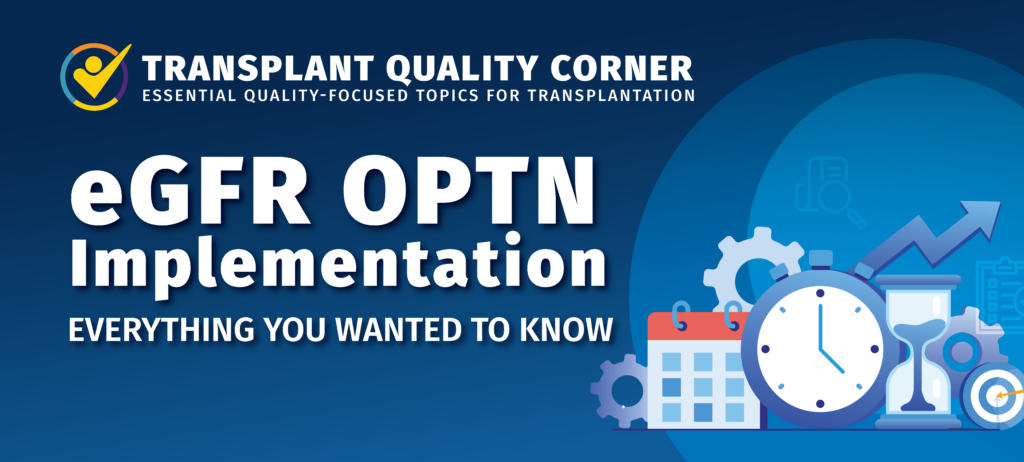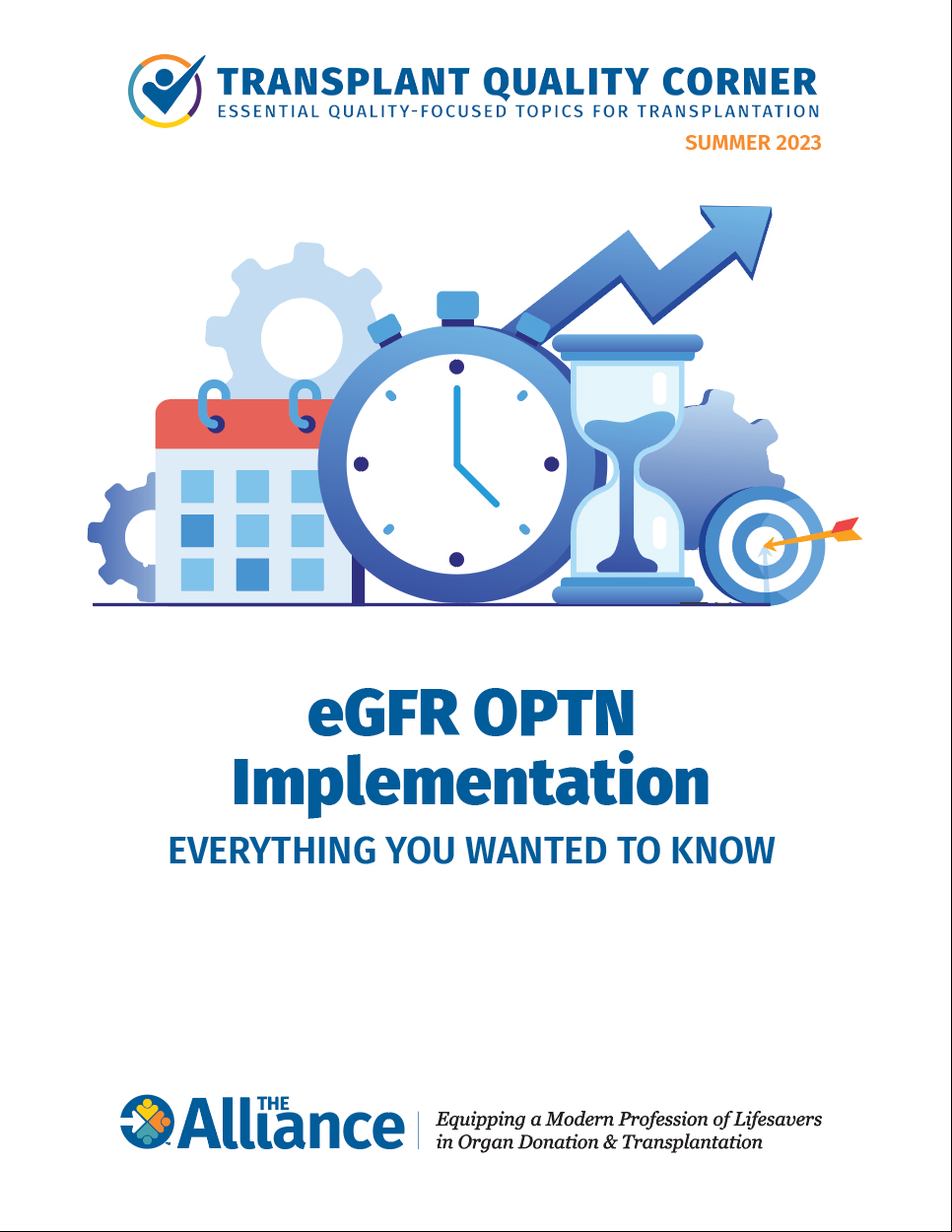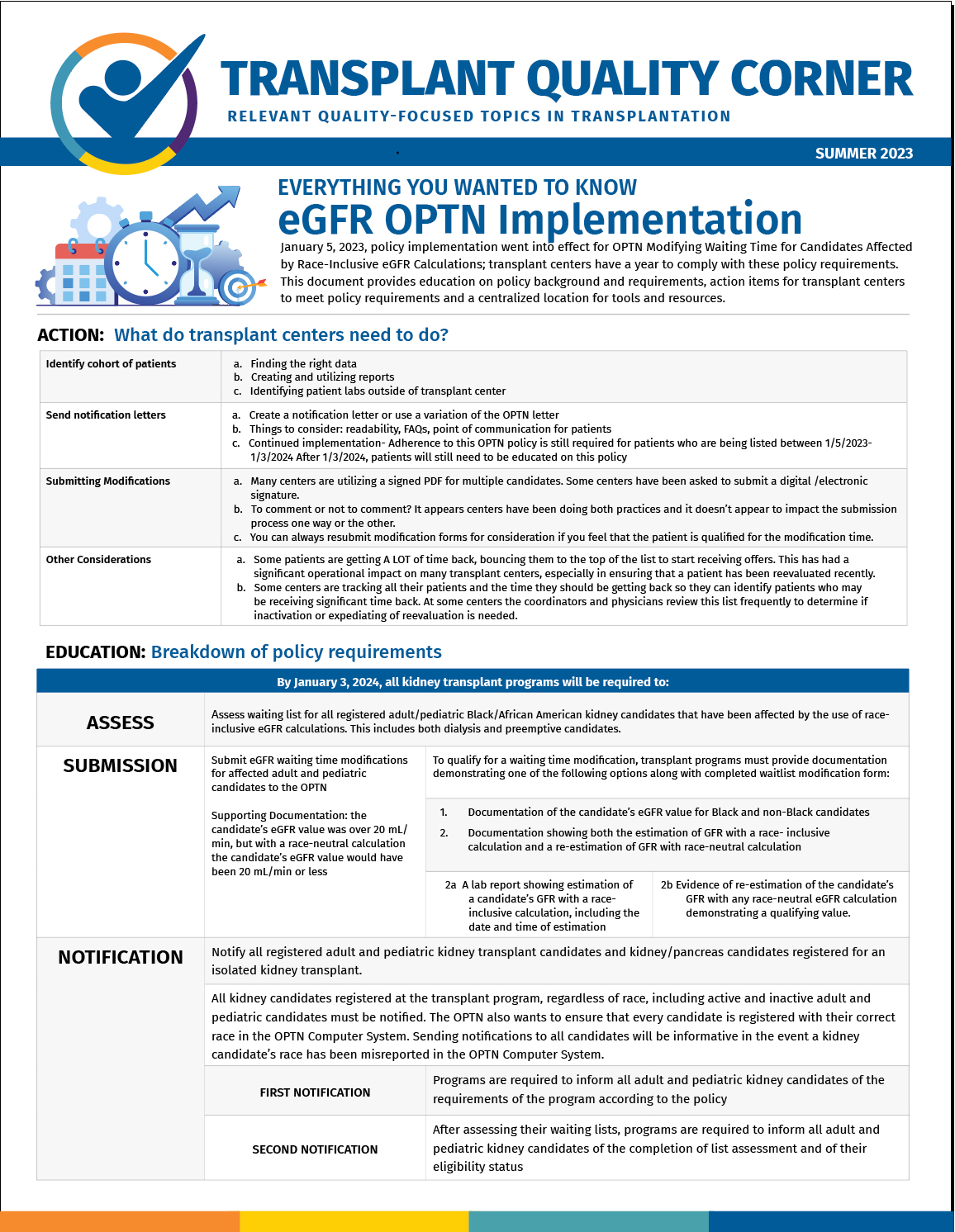The Alliance
Insight Series
The Alliance insight series offers critical resources for stakeholders across the donation and transplantation continuum. For each topic, you can find related action items, tools, and references.
Summer 2023
IN THIS ISSUE
The Alliance Insight Series
Feedback & Suggestions Welcome
Your input is valuable to us as it helps improve our programs and offerings in order to provide you with vital updates and essential information. Please feel free to share your thoughts and ideas with us.

SUMMER 2023

Executive Summary
On January 5, 2023, policy implementation went into effect for OPTN Modifying Waiting Time for Candidates Affected by Race-Inclusive eGFR Calculations. Transplant centers have a year to comply with these policy requirements. This document provides action items for transplant centers to meet policy requirements, education on policy background and requirements, and a centralized location for tools and resources.
Action
What do transplant centers need to do?
Identify cohort of patients
- Finding the right data:
| OPTN DATA | EMR DATA | OTHER HELPFUL ELEMENTS |
|---|---|---|
| Waitlisted patient demographics (i.e. name, SSN, Center ID) |
GFR lab results | Dialysis Unit |
| Candidate Race | GFR AA lab results | GFR AA lab results |
| Listing Date | EMR race | Referring Practice |
| Qualifying Date | Demographic information |
-
Creating/ Utilizing reports:
-
Utilize the OPTN custom reporting tool in the data services portal “Current waitlisted African American Candidates” provides a list of current kidney candidates reported with AA/Black as race with wait time qualifying information.
-
Create and use reports built in EMR system.
-
A combination of both and a master spreadsheet to track where patients are in the process.
-
-
Identifying patient labs outside transplant center:
-
Accessing outside labs through care everywhere if you have EPIC.
-
Using record retrieval technology (e.g. E-health)
-
Collaborating with dialysis centers and referring practices:
-
Providing education on what exactly is needed for the patient vs. having all lab results sent to the transplant center to comb through.
-
Utilizing referral packets as a first step in identification of previous lab results
-
-
Patient Advocacy – Engage with patients to find past lab results that might be eligible for wait time modification.
-
Send Notification Letters:
-
Create a notification letter or use a variation of the OPTN letter. We have included some samples of letters developed in the resource section.
-
Letter tips:
-
No OPTN language on timeframe between notification #1 and #2
-
Dialysis center notification not required but may need to collaborate for records.
-
Notification #2: Sent after reviewing waitlist. Consider creating 2 notification templates- ELIGIBLE and NON-ELIGIBLE. All patients who do not identify as Black or African American (AA) are non-eligible by default
-
-
WARNING – We have heard that patients have experienced confusion around some of the individualized letters especially those that are listed at multiple transplant centers. To help combat this:
-
Think about creating a FAQ to include with your letter.
-
Consider having patient education review your letter for readability. Identify and include in the letter who patients can contact if they have questions.
-
Due to the complexities around this policy, centers have identified specific people to answer patient questions or provided education/ resources to access centers.
-
-
Continued Implementation- Adherence to this OPTN policy is still required for patients who are being listed between 1/5/2023-1/3/2024. After 1/3/2024, patients will still need to be educated on this policy. How will your center continue to provide this information over the year?
-
Update listing process to include the additional letter at listing.
-
Consider building this policy information into your evaluation education.
-
Submit Modifications: Challenges and Lessons Learned
-
Many centers are utilizing a signed PDF for multiple candidates. Some centers have been asked to submit a digital/ electronic signature.
-
To comment or not to comment? It appears centers have been doing both practices on the modification form, it doesn’t appear to impact the submission process one way or the other.
-
You can always resubmit modification forms for consideration if you feel that the patient is qualified for the modification time.
Other Considerations:
-
Some patients are getting A LOT of time back, bouncing them to the top of the list to start receiving offers. This has had a significant operational impact on many transplant centers, especially in ensuring that a patient has been reevaluated recently.
-
Some centers are tracking all their patients and the time they should be getting back so they can identify patients who may be receiving significant time back. At some centers the coordinators and physicians review this list frequently to determine if inactivation or expediating of reevaluation is needed.
Education
Background
In January 2022, the OPTN Minority Affairs and Kidney Transplantation Committees proposed Establish OPTN Requirement for Race- Neutral eGFR Calculations to require eGFR calculations used for the purposes of the OPTN be race-neutral. Race-inclusive calculations can overestimate Black candidates’ eGFR values and result in a delayed start of waiting time accrual to receive a kidney transplant. In August of 2022 the OPTN Minority Affairs and Kidney Transplantation Committees proposed Modify Waiting Time for Candidates Affected by Race-Inclusive eGFR Calculations to provide a pathway for registered candidates who have been impacted by a race-inclusive eGFR calculation to regain waiting time they could have received if a race-neutral calculation was used to estimate their GFRs.
Timeline
This policy took effect January 5, 2023. Transplant programs must comply with this policy by January 3, 2024.
- Black/African American candidates registered from January 5, 2023, until Jan 3, 2024, are required to be assessed for eligibility for a potential waiting time modification.
- Black/African American candidates registered after January 3, 2024, remain eligible.
Specifics of Qualifying Candidates
Qualifying candidates must meet all the following criteria to be eligible for a waiting time modification:
- Currently registered as Black or African American in the OPTN Computer System
- Previously had their eGFR value calculated with a race-inclusive formula.
- Presently accruing waiting time with eGFR, Creatinine Clearance (CrCl), or dialysis criteria (See OPTN Policy 8.3.A) OR are registered without qualifying criteria.
- Transplant program can provide documentation demonstrating that with a race-inclusive calculation, the candidate’s eGFR was over 20 mL/min, but with a race-neutral calculation the candidate’s eGFR would have been 20 mL/min or less.
Eligible candidates may also include:
- Black/African American adult and pediatric candidates registered on the OPTN waiting list.
- Black/African American candidates registered for a Kidney- Pancreas or multi-organ transplant: if they are registered for an isolated kidney.
- Candidates registered on the OPTN waiting list, with multiple races: If one of those races is Black or African- American
Breakdown of Policy Requirements
| By January 3, 2024, all kidney transplant programs will be required to: | |||
|---|---|---|---|
| Assess | Assess waiting list for all registered adult/pediatric Black/African American kidney candidates that have been affected by the use of race-inclusive eGFR calculations. This includes both dialysis and preemptive candidates. | ||
| SUBMISSION | Submit eGFR waiting time modifications for affected adult and pediatric candidates to the OPTN
Supporting Documentation: the candidate’s eGFR value was over 20 mL/min, but with a race-neutral calculation the candidate’s eGFR value would have been 20 mL/min or less |
To qualify for a waiting time modification, transplant programs must provide documentation demonstrating one of the following options along with completed waitlist modification form: | |
| 1. Documentation of the candidate’s eGFR value for Black and non-Black candidates 2. Documentation showing both the estimation of GFR with a race- inclusive calculation and a re-estimation of GFR with race-neutral calculation |
|||
| 2a A lab report showing estimation of a candidate’s GFR with a race-inclusive calculation, including the date and time of estimation | 2b Evidence of re-estimation of the candidate’s GFR with any race-neutral eGFR calculation demonstrating a qualifying value. | ||
| NOTIFICATION | Notify all registered adult and pediatric kidney transplant candidates and kidney/pancreas candidates registered for an isolated kidney transplant. | ||
| All kidney candidates registered at the transplant program, regardless of race, including active and inactive adult and pediatric candidates must be notified. The OPTN also wants to ensure that every candidate is registered with their correct race in the OPTN Computer System. Sending notifications to all candidates will be informative in the event a kidney candidate’s race has been misreported in the OPTN Computer System. | |||
| FIRST NOTIFICATION | Programs are required to inform all adult and pediatric kidney candidates of the requirements of the program according to the policy | ||
| SECOND NOTIFICATION | After assessing their waiting lists, programs are required to inform all adult and pediatric kidney candidates of the completion of list assessment and of their eligibility status | ||
| ATTESTATION | OPTN policy requires transplant programs to submit documentation attesting to both of the following: | That the transplant program has provided notification to all candidates registered at the transplant program of their eligibility for a waiting time modification according to this policy and | |
| That the transplant program has submitted eGFR waiting time modifications for all eligible candidates registered at the transplant program | |||
| The attestation can be submitted at any time after a program has gone through their initial identified patient list. | |||
Tools & Resources
- Educational Offering in the OPTN Learning Management System (also known as UNOS Connect)
- Course KID118: Waiting Time Modifications for Kidney Candidates Affected by Race- Inclusive eGFR Calculations.
- Sample candidate notification and attestation documentation
- Course KID118: Waiting Time Modifications for Kidney Candidates Affected by Race- Inclusive eGFR Calculations.
- OPTN Toolkit Waiting Time Modifications for Kidney Candidates Affected by Race- Inclusive eGFR Calculations
- FAQs for professionals
- FAQs for patients
- eGFR implementation webinar
- Examples of race-neutral calculators:
- Programs may use any eGFR calculator that does not include a race variable.
- CKD- EPI 2021 has been refit without race by the National Kidney Foundation and American Society of Nephrology
- GFR Estimate by MDRD-4 variable equation and all other race inclusive calculators can be made race neutral by selecting “No” for “Black Race”
- Programs may use any eGFR calculator that does not include a race variable.
- Sample Notification Letters
A SPECIAL THANKS TO THIS ISSUE’S CONTRIBUTORS
We would like to express our sincerest gratitude for our contributors’ tireless efforts on making Transplant Quality Corner a reality. Their dedication and expertise have been an invaluable contribution to the successful launch of this project. We are incredibly grateful for all their hard work and commitment.
A SPECIAL THANKS TO THE TRANSPLANT QUALITY CORNER WORKGROUP
FEEDBACK
If there is content you feel that should be added or was lacking, we would like to hear from you. Positive feedback on what is working for you, is also welcomed. Thank you for taking the time to provide us with your feedback.














